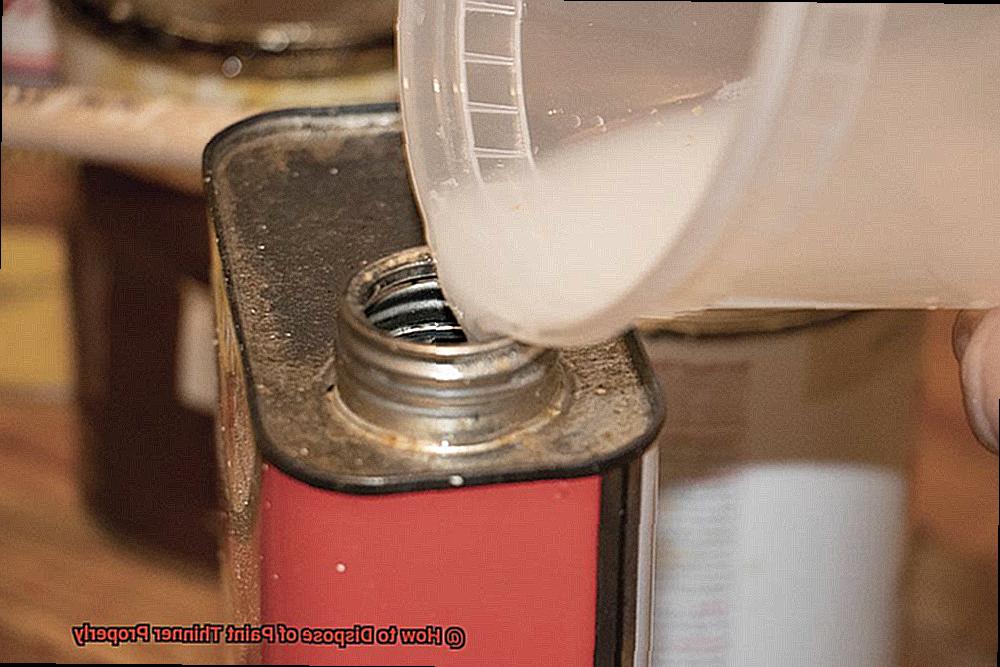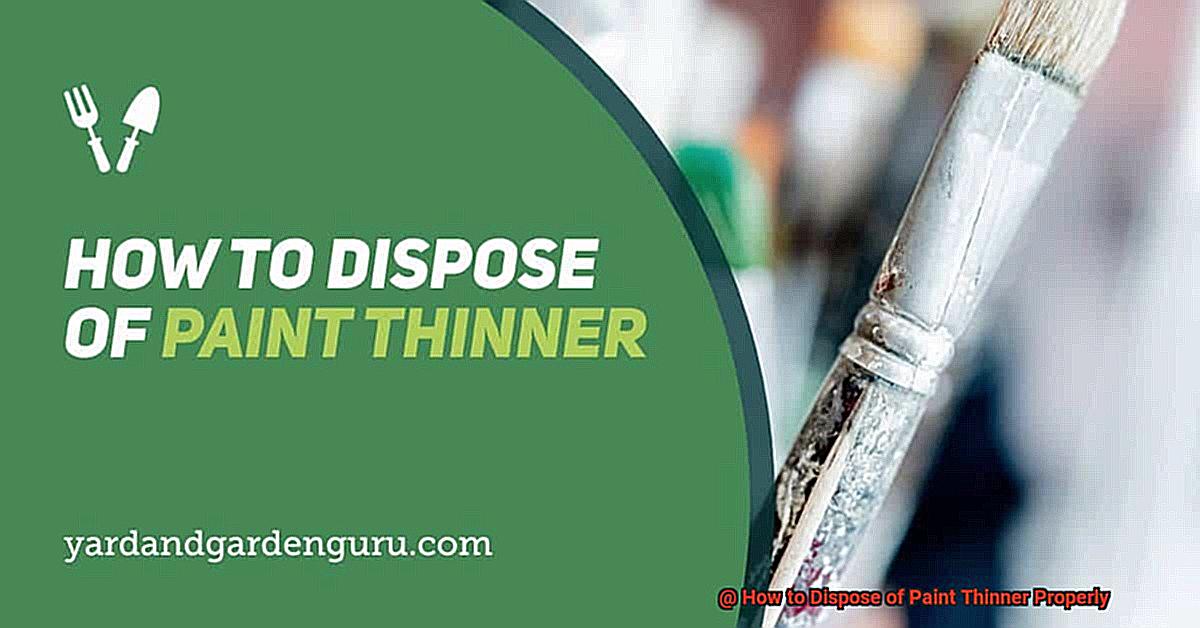Have you ever used paint thinner on a project? If so, you know how important it is to dispose of it properly.
But many people don’t understand the risks of improper disposal. It can cause environmental harm and put them in danger.
So, let’s learn how to get rid of paint thinner safely and responsibly. We’ll look at the different types of thinners, the risks of improper disposal, and the best ways to dispose of them.
Join us as we explore how to do our part for the environment while keeping ourselves safe.
Where to Dispose of Paint Thinner
Contents
- 1 Where to Dispose of Paint Thinner
- 2 How to Dispose of Paint Thinner Properly
- 3 Can You Reuse Old Paint Thinner?
- 4 What Effects Does Paint Thinner Have On The Environment?
- 5 Alternatives to Disposing of Paint Thinner Properly
- 6 Common Misconceptions About Disposing Of Paint Thinner Properly
- 7 Tips for Safely Handling and Storing Paint Thinners
- 8 Safety Precautions When Using or Disposing Of Paint Thinners
- 9 Conclusion
Are you looking for the best way to dispose of paint thinner? Knowing where and how to do it properly is essential.
The most effective way to get rid of paint thinner is at a local hazardous waste facility or through a household hazardous waste collection program. To find out if these services are available in your area, contact your local government.
It’s also important to check with your state or local environmental agency for regulations regarding the disposal of paint thinner in your area.
You should also contact the local fire department or public works department for more information on how to safely and responsibly dispose of paint thinner. Some communities may even have a drop-off location for hazardous materials such as paint thinners.
It’s important to be aware of the correct disposal techniques for paint thinners.
Doing so will ensure that it is disposed of properly and in accordance with all laws.
How to Dispose of Paint Thinner Properly
It is essential to be aware of the proper way to dispose of paint thinner, as improper disposal can have serious environmental consequences.
Paint thinner should never be thrown in the trash or poured down the drain, as this can contaminate soil and water.
The best way to get rid of paint thinner is to take it to a hazardous waste facility, where it will be collected safely and properly.
Before disposing of paint thinner, you should also check with your local government for specific instructions on how to do so, as these can vary from region to region.
You may be able to donate small amounts of paint thinner to a local auto parts store or home improvement store for recycling.
Some cities may even provide curbside pickup for paint thinner disposal, so make sure you check with your local government about this option too.
Recycling centers may also accept paint thinner for recycling, so if you have large amounts of paint thinner that need disposing of, this could be an option worth considering.
If you have more than you can handle yourself, you may need to hire a licensed hazardous waste disposal firm.
Finally, it is always preferable to reuse old paint thinner because it reduces the amount of hazardous materials that must be disposed of in the first place.
When it comes time to dispose of your old paint thinner, make sure you do it responsibly and safely – both for your own safety and for the sake of the planet.
Can You Reuse Old Paint Thinner?
The answer is a resounding no.

Paint thinner is a highly flammable and toxic substance, so it should be disposed of properly. Reusing or recycling paint thinner can be dangerous and cause health risks if inhaled or ingested. It’s best to always use fresh paint thinner for each new project.
Paint thinners are composed of several different chemicals, including acetone, toluene, and xylene.
If exposed, these chemicals can cause irritation to the eyes, skin, and lungs. They also evaporate quickly into the air and create a risk of fire or explosion if exposed to sparks or flames.
In some cases, it may be possible to clean out a container of old paint thinner and reuse it for a new project. However, this should only be done with extreme caution, as there may still be residue from the previous use that could contaminate the new paint job.
What Effects Does Paint Thinner Have On The Environment?
Paint thinners can be incredibly damaging to the environment if not handled properly.
Paint thinner contains volatile organic compounds (VOCs), which can easily evaporate into the air, causing pollution and contributing to ground-level ozone—a dangerous pollutant that is harmful to both human health and the environment.
Furthermore, paint thinner can contaminate groundwater sources if it seeps into soil or water sources, as well as harm marine life if it is released into oceans or other waterways.
To reduce its environmental impact, paint thinner should always be disposed of in accordance with local regulations and laws.
Alternatives to Disposing of Paint Thinner Properly
Have you ever finished painting and wondered what to do with the leftover paint thinner? Many people don’t realize that there are alternatives to properly disposing of paint thinner.
One option is to recycle the used paint thinner at a local hazardous waste collection center. This is beneficial as it decreases the amount of hazardous waste in the environment.
However, be sure to check your local laws before attempting this option, as some places may not offer this service.
Another alternative is to reuse the paint thinner yourself by safely storing it in an airtight container until you need it again. This will save you money and help keep your home free of hazardous chemicals.
In addition, you may also consider using a water-based paint instead of a solvent-based one. Water-based paints are much less harmful than solvent-based paints, and they don’t require thinners to clean up after use.
This is an environmentally friendly way to reduce your carbon footprint and keep your house free from hazardous chemicals.
Overall, there are several options for disposing of paint thinners properly, which can minimize your environmental impact while still keeping your home safe from dangerous chemicals.
Before deciding which one is right for you, be sure to research all available choices thoroughly.
Common Misconceptions About Disposing Of Paint Thinner Properly
Here are some of the most common misconceptions about disposing of paint thinner properly.
You can pour paint thinner down the drain. This is a definite no-no! Paint thinner is highly flammable, and if poured down the drain, it can contaminate our water supply and damage the environment.
You can reuse old paint thinners. Unfortunately, this isn’t true either. Old paint thinners may contain contaminants that could be hazardous to your health or to the environment if used in a new project.
Paint thinner has no effect on the environment. The truth is that paint thinner is hazardous and can have a negative impact on our planet if not disposed of properly. It contains volatile organic compounds (VOCs), which can contribute to air pollution, groundwater contamination, and other environmental issues.
To ensure safe disposal of paint thinner, take it to your local hazardous waste facility or contact your local government for more information on proper disposal procedures. Following these tips will help protect our planet from further harm!
Tips for Safely Handling and Storing Paint Thinners
Paint thinners are essential for a variety of painting jobs, but if not treated with care, they can be hazardous. Here are eight tips to help you safely handle and store paint thinners to ensure safety and avoid any accidents.
Wear Protective Gear
Whenever you use paint thinners, it is important to wear protective gloves, a mask, and eye protection to avoid contact with the skin or eyes. This will protect you from any potential health issues associated with the chemicals in paint thinners.
Store in a Cool, Dry Place
Always store paint thinners in a cool, dry area away from any heat sources or flames. When not in use, make sure the lid of the container is tightly closed to prevent accidental leaks or evaporation of the product. Additionally, label containers clearly with the contents, date of purchase, and expiration date.
Avoid Cross-Contamination
When dealing with paint thinner, it is important to use a dedicated container to avoid cross-contamination with other materials or chemicals. Never mix different types of paint thinner together, as this can create hazardous fumes that can be harmful to your health and the environment if released into the air or water supply.
Dispose Properly
If you have old or unused paint thinner that you need to get rid of, dispose of it at an approved hazardous waste facility or collection site according to local regulations. Never pour paint thinner down the drain or into storm sewers, as it can contaminate water sources and cause environmental damage.
Keep Out of Reach of Children and Pets
It is essential that containers containing paint thinner be kept out of reach of children and pets at all times in order to prevent accidental ingestion or contact with skin or eyes, which can cause serious injury or death if not treated immediately by a medical professional.
Safety Precautions When Using or Disposing Of Paint Thinners
Using paint thinners can be a great way to tackle a variety of DIY projects. But it’s important to use them safely and dispose of them properly. Here are some essential safety precautions for using and disposing of paint thinners.
When using paint thinners, always wear protective gear such as gloves, goggles, and a respirator.
Work in a well-ventilated area and store paint thinners away from heat sources. When not in use, keep containers closed, and never mix paint thinner with other chemicals.
Don’t just throw it away when you’re finished using paint thinner.
For proper disposal instructions, contact your local hazardous waste disposal center. When transporting the paint thinner to the disposal center, take all necessary safety precautions. Never pour leftover paint thinner down the drain or into any body of water.
If not disposed of correctly, improper disposal of paint thinners can have serious environmental consequences.
Contamination of groundwater and soil can occur if not treated properly, potentially posing health risks to people living near contaminated areas.
To avoid these risks, make sure you follow these safety instructions when using or disposing of paint thinners.
Conclusion
Paint thinners are a necessary part of many DIY projects, but they must be handled with care.
Wear protective gear when using them, store them away from heat sources, and never mix different types of paint thinners together.
Dispose of them at a licensed hazardous waste facility to keep yourself safe and protect the environment. For an even greater impact, switch to water-based paints instead of solvent-based ones.





